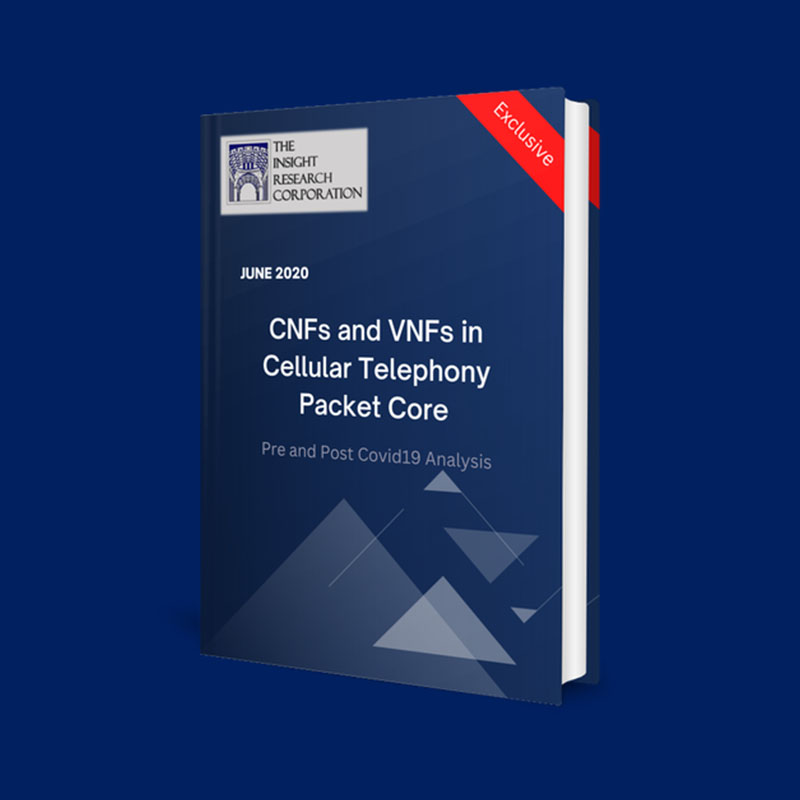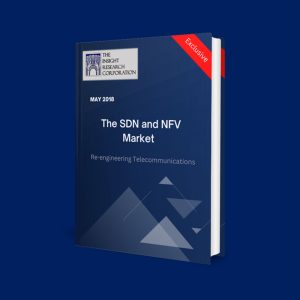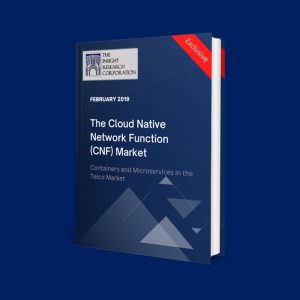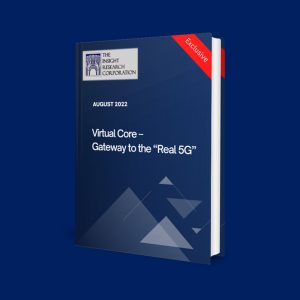Description
Core VNFs, or vEPCs are fast becoming the norm. A significant improvement from their outlier status in comparison with conventional network switches a few years back. Admittedly, the role played by LTE use-cases has been very useful for firmly establishing the Core VNFs. The status of VNFs faces imminent threat from the emergence of its sleeker and agile successor in the form of CNFs. It helps that 5GC is poised to cloud native in the SA version. Core lends itself very favorably to microservices.
Highlights
Insight Research forecasts that Core CNFs will reach within striking distance of the $1 billion revenue mark by 2025, notwithstanding the shock of 2020.
Scope
Chapter 1 is the Executive Summary (Available for Download)
Chapter 2 compares and contrasts the origins, morphologies and features of the principal actors in this report – CNFs and VNFs.
Chapter 3 places VNFs and CNFs in the realms of the network functions covered in the report – the core.
Chapter 4 highlights, analyses and chronicles the CNF and VNF-related initiatives of the most important stakeholders – the telcos
Chapter 5 identifies and categorises the vendors or solution providers; and analyses their initiatives in the context of the network functions covered.
Chapter 6 covers the quantitative forecasts in providing ringside as well as inside views of the VNF and CNF markets for the core by breaking them along morphology, geographical region, deployment methodology, hosting mode, end-user and application criteria.
Table of Contents
1 Executive Summary
1.1 The CNF-VNF Rivalry
1.2 The Umbilical Cord Between CNFs and VNFs
1.3 Why will CNFs Outpace VNFs?
1.4 Cautionary Note for CNFs
1.5 Report Organization and Market Forecast Taxonomy
2 VNFs and CNFs
2.1 VNF -The Original
2.1.1 History and Progression
2.1.2 NFV architecture
2.1.2.1 VNFi/NFVi
2.1.2.2 VNFs
2.1.2.3 MANO
2.2 CNF – The Inheritor
2.2.1 What are Containers?
2.2.2 Microservices
2.2.3 Container Morphology
2.2.3.1 Provisioning and Run-time Management Block
2.2.3.1.1 Docker Engine
2.2.3.2 Orchestration Block
2.2.3.2.1 Kubernetes
2.2.3.3 Application Deployment Block
2.2.4 Container Deployment Methodologies
2.2.4.1 Virtual Machine (VM)
2.2.4.2 Bare Metal
2.2.4.3 Cloud or Container as-a-Service (CaaS)
2.2.5 Stateful and Stateless Containers
2.2.6 CNCF and CNFs
2.3 Contrasting CNF and VNFs
2.4 Advantage CNF
2.4.1 Freedom from Hypervisors
2.4.2 File-level Resource Management
2.4.3 Portability
2.4.4 Microservices-powered Scalability and Granularity
2.4.5 Quick Operationalization
2.4.6 Quick Orchestration with a Caveat
2.4.7 Containers and 5G
2.5 Advantage VNFs .. and PNFs
2.5.1 Familiarity with VMs
2.5.2 Telco Demands
2.5.3 Latency
2.5.4 Security
2.5.5 Flexibility
2.5.6 Hardware Enhancements
2.5.7 Co-existence with PNFs and VNFs
2.6 Blending CNF with NFV
2.6.1 NFVi and CNF
2.6.2 MANO and CNF
2.6.2.1 ONAP and CNFs
2.6.2.1.1 ONAP4K8S
2.6.2.2 OSM and CNFs
3 VNFs and CNFs of the Core
3.1 The Core and its Evolution
3.2 Contours of EPC
3.2.1 SAE and the Flat Architecture
3.2.2 Decoupling of Planes
3.2.3 NAS
3.2.4 Blocks in the EPC
3.2.4.1 SGW
3.2.4.2 PGW
3.2.4.3 ePDG
3.2.4.4 TWAG
3.2.4.5 MME
3.2.4.6 HSS
3.2.4.7 Other optional elements
3.3 The 5G Core (5GC)
3.4 The Core VNF and CNF Dynamic
3.4.1 Prelude – Mounting Challenges for the Core
3.4.2 The Remedy
3.4.3 The Mechanics
3.4.4 The Challenges
3.5 The Core – Vendor Approaches
3.5.1 VNF/vEPC
3.5.2 CNF
4 Telco Profiles
4.1 Core – CNF and VNF Trends
4.1.1 Salient Observations and Inferences
4.2 Telco profiles
4.3 Airtel
4.3.1 Core CNF and VNF Initiatives
4.4 AT&T
4.4.1 Core CNF and VNF Initiatives
4.5 BT
4.5.1 Core CNF and VNF Initiatives
4.6 China Mobile
4.6.1 Core CNF and VNF Initiatives
4.7 China Telecom
4.7.1 Core CNF and VNF Initiatives
4.8 China Unicom
4.8.1 Core CNF and VNF Initiatives
4.9 Deutsche Telekom
4.9.1 Core CNF and VNF Initiatives
4.1 Etisalat
4.10.1 Core CNF and VNF Initiatives
4.11 Jio
4.11.1 Core CNF and VNF Initiatives
4.12 KDDI
4.12.1 Core CNF and VNF Initiatives
4.13 KT
4.13.1 Core CNF and VNF Initiatives
4.14 LG Uplus
4.14.1 Core CNF and VNF Initiatives
4.15 Lifecell Ukraine
4.15.1 Core CNF and VNF Initiatives
4.16 M1 Singapore
4.16.1 Core CNF and VNF Initiatives
4.17 NTT DoCoMo
4.17.1 Core CNF and VNF Initiatives
4.18 Ooredoo
4.18.1 Core CNF and VNF Initiatives
4.19 Optus (Singtel Optus)
4.19.1 Core CNF and VNF Initiatives
4.2 Orange
4.20.1 Core CNF and VNF Initiatives
4.21 Rakuten
4.21.1 Core CNF and VNF Initiatives
4.22 Saudi Telecom (STC)
4.22.1 Core CNF and VNF Initiatives
4.23 Singtel
4.23.1 Core CNF and VNF Initiatives
4.24 SK Telecom
4.24.1 Core CNF and VNF Initiatives
4.25 Softbank
4.25.1 Core CNF and VNF Initiatives
4.26 Sprint Corporation
4.26.1 Core CNF and VNF Initiatives
4.27 Swisscom
4.27.1 Core CNF and VNF Initiatives
4.28 T-Mobile
4.28.1 Core CNF and VNF Initiatives
4.29 TIM/Telecom Italia
4.29.1 Core CNF and VNF Initiatives
4.3 Telenor
4.30.1 Core CNF and VNF Initiatives
4.31 Telefonica
4.31.1 Core CNF and VNF Initiatives
4.32 Telia
4.32.1 Core CNF and VNF Initiatives
4.33 Telkom Indonesia
4.33.1 Core CNF and VNF Initiatives
4.34 Telstra
4.34.1 Core CNF and VNF Initiatives
4.35 Turk Telecom
4.35.1 Core CNF and VNF Initiatives
4.36 Turkcell
4.36.1 Core CNF and VNF Initiatives
4.37 Veon VimpelCom
4.37.1 Core CNF and VNF Initiatives
4.38 Verizon
4.38.1 Core CNF and VNF Initiatives
4.39 Vodafone
4.39.1 Core CNF and VNF Initiatives
5 Solution Provider Profiles
5.1 Organization Categories
5.1.1 Telecommunications Domain Experts
5.1.2 Equipment Vendors
5.1.3 Independent Software Vendors (ISV)
5.1.4 Semiconductor Specialists
5.1.5 Hardware, OS and Firmware Specialists
5.1.6 Niche Solution Developers
5.2 The Maturing of Core VNFs and CNFs
5.3 Mergers and Funding Related Developments
5.4 Company Profiles
5.5 6WIND
5.5.1 Core CNF and VNF Initiatives
5.5.1.1 6WINDGate
5.6 Affirmed Networks
5.6.1 Core CNF and VNF Initiatives
5.6.1.1 vEPC
5.6.1.2 Virtual Slice Selection Function (vSSF)
5.6.1.3 UnityCloud
5.7 Athonet
5.7.1 Core CNF and VNF Initiatives
5.7.1.1 Connectivity Platform
5.8 Baicells
5.8.1 Core CNF and VNF Initiatives
5.8.1.1 vEPC/LTE Core
5.9 Cirrus Core Networks (CCN)
5.9.1 Core CNF and VNF Initiatives
5.9.1.1 vEPC
5.9.1.2 vIMS
5.1 Cisco Systems
5.10.1 Core CNF and VNF Initiatives
5.10.1.1 Ultra-Packet Core
5.10.1.2 Network Convergence System 540 Fronthaul Routers
5.10.1.3 Other Developments
5.11 Dell EMC
5.11.1 Core CNF and VNF Initiatives
5.11.1.1 Open Networking Switches
5.11.1.2 Other Developments
5.12 Enea
5.12.1 Core CNF and VNF Initiatives
5.12.1.1 Unified Data Manager
5.12.1.2 Other Developments
5.13 Ericsson
5.13.1 Core CNF and VNF Initiatives
5.13.1.1 Cloud Native Application (CNA)
5.13.1.2 Ericsson – Cloud Packet Core
5.13.1.3 Cloud-native NFVi
5.13.1.4 Other Developments
5.14 Huawei
5.14.1 Core CNF and VNF Initiatives
5.14.1.1 CloudEPC
5.14.1.2 5G Core
5.14.1.3 Other Initiatives
5.15 Intel
5.15.1 Core CNF and VNF Initiatives
5.15.1.1 FPGA
5.15.1.2 Other Developments
5.16 Mavenir
5.16.1 Core CNF and VNF Initiatives
5.16.1.1 Cloud Native IMS
5.16.1.2 5G Core
5.16.1.3 vEPC
5.16.1.4 Other Developments
5.17 Metaswitch
5.17.1 Core CNF and VNF Initiatives
5.17.1.1 Clearwater IMS Core
5.17.1.2 Other Developments
5.18 NEC/Netcracker
5.18.1 Core CNF and VNF Initiatives
5.18.1.1 NEC – vEPC
5.18.1.2 Other Developments
5.19 Nokia
5.19.1 Core CNF and VNF Initiatives
5.19.1.1 Nokia – Cloud Packet Core
5.19.1.1.1 CMM
5.19.1.1.2 CMG
5.19.1.2 Telecom Application Server
5.19.1.3 Other Developments
5.2 Oracle
5.20.1 Core CNF and VNF Initiatives
5.20.1.1 Assorted Core NFs
5.21 Quortus
5.21.1 Core CNF and VNF Initiatives
5.21.1.1 ECX Core
5.21.1.2 Other Developments
5.22 Radisys
5.22.1 Core CNF and VNF Initiatives
5.22.1.1 MediaEngine
5.22.1.2 Other Developments
5.23 Red Hat
5.23.1 Core CNF and VNF Initiatives
5.23.1.1 OpenShift Container Platform
5.23.1.2 Ansible
5.23.1.3 Other Developments
5.24 Samsung
5.24.1 Core CNF and VNF Initiatives
5.24.1.1 Samsung 5G Core
5.24.1.2 AdaptiV
5.24.1.3 Other Developments
5.25 Telrad Networks
5.25.1 Core CNF and VNF Initiatives
5.25.1.1 BreezeWAY
5.26 VMware
5.26.1 Core CNF and VNF Initiatives
5.26.1.1 NSX
5.26.1.2 X-Factor
5.26.1.3 Other Developments
5.27 Wind River
5.27.1 Core CNF and VNF Initiatives
5.27.1.1 Titanium Cloud Product Portfolio
5.27.1.2 Kubernetes
5.28 ZTE
5.28.1 Core CNF and VNF Initiatives
5.28.1.1 Cloud Common Core
5.28.1.2 vEPC
5.28.1.3 TECS
5.28.1.4 Other Developments
6 Quantitative Forecasts
6.1 Research Methodology
6.2 Forecast Taxonomy
6.3 Foreword
6.3.1 CNF/Container Morphology
6.3.2 CNF Deployment Methodology
6.3.3 Geographical Market
6.3.4 End-user
6.4 Analysis of the Core VNF and CNF Market
6.4.1 CORE VNF
6.4.2 Core CNF
7 Glossary and Acronyms




